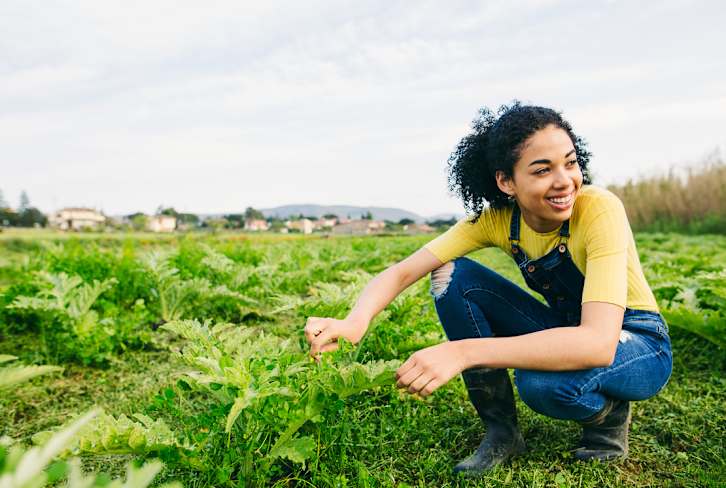Advertisement
How To Raise The Next Generation Of Healthy (And Eco-Friendly) Eaters


Getting your kids to eat healthily is hard enough—getting them to eat healthy and sustainably? Practically unheard of.
However, there's one simple practice that you can do with your kids that will make them actually want to eat whole, plant-based foods while also fostering their love for the environment around them. I'm talking about growing your own food.
Why gardening with your kids is so important.

To see how gardening can help parents get their kids interested in real food, just take a look at the New York Botanical Garden. Its newly renovated Edible Academy seeks to impart a love of all things plant-based to the next generation. Part farm, part education center, its vast array of programming gives schoolkids, families, and teachers the opportunity to learn about how to grow fruits and veggies, snag some new cooking techniques, and take home fresh produce of their own.
When I visited the Academy earlier this summer, I was struck by its unique commitment to sustainable, regenerative growing practices: At Edible Academy, it's not enough for kids to learn how to grow tomatoes—they are taught how to do so in a way that reinvigorates soil. Compost piles play a central role in the curriculum, and water conservation is prized above all else.
I caught up with James Boyer, NYBG's vice president for Children's Education, for his advice on how to teach children to eat healthier and be little stewards of the environment while they're at it.
Here's how it's done:
1. Let kids get their hands dirty.
Boyer's top piece of advice? Grow some of your own food at home—even if it's just on your windowsill. If you don't fancy yourself much of a green thumb, start with easy-to-grow crops (PSA to parents in the New York area: radishes, lettuce, carrots, and basil all have short growing seasons—so if you plant them right now, you can get a small harvest come winter!), and learn together with your child by trial and error. Including your kid in the process will teach them where their food comes from and boost their confidence in the process. "There's something very beautiful about the sense of accomplishment—it's frequently people's favorite thing about gardening," he says.
2. Keep it eco-friendly, but don't overcomplicate things.
When you're growing food in your own space, chances are it will be a small-scale operation so you can easily use earth-friendly techniques. "Most people can do this stuff in an organic fashion and use the techniques that people have been using for hundreds of thousands of years," he says. His two tips for doing this? Put compost on your garden instead of fertilizing, and hand-weed instead of spraying herbicides. And be sure to tell your kids why you're doing things the way you are and incorporate sustainable lessons whenever possible (here are a few to start with!).

But remember, there's no reason to get too in the weeds, so to speak (sorry). "Planting, cooking, and nutrition education should be fun—it doesn't have to be so complicated." If you're lucky enough to have a backyard, that means leaving a little space for kids to roam and just enjoy the outdoors, too.
"We always like to have a spot that is empty and has nothing in it so kids can play in the soil. It's actually one of the most popular spots. We joke around that we have all these beautiful vegetables growing, and you can ask a little 4-year-old what their favorite part was and they'll say 'getting my hands dirty and finding the worms,'" he says.
3. Watch their palates expand.
Farming with your kids comes with another unexpected benefit: It might make kids more open to new foods. "Kids are much more likely to try something if they harvested it themselves," Boyer says, joking that the kids at Edible Academy often don't even want to wait to wash their produce before they take a bite. "The more kids can actually see whole foods before they get on their plate, the more tempted they will be to try them. It's nice to see because that's the first step in getting kids to eat more foods—and healthier foods."
Watch Next
Enjoy some of our favorite clips from classes
Enjoy some of our favorite clips from classes
What Is Meditation?
Mindfulness/Spirituality | Light Watkins
Box Breathing
Mindfulness/Spirituality | Gwen Dittmar
What Breathwork Can Address
Mindfulness/Spirituality | Gwen Dittmar
The 8 Limbs of Yoga - What is Asana?
Yoga | Caley Alyssa
Two Standing Postures to Open Up Tight Hips
Yoga | Caley Alyssa
How Plants Can Optimize Athletic Performance
Nutrition | Rich Roll
What to Eat Before a Workout
Nutrition | Rich Roll
How Ayurveda Helps Us Navigate Modern Life
Nutrition | Sahara Rose
Messages About Love & Relationships
Love & Relationships | Esther Perel
Love Languages
Love & Relationships | Esther Perel











